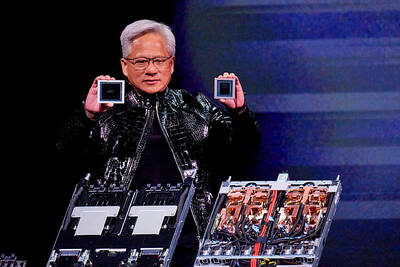Barbie has been many things in her life: A doctor, a paleontologist, an astronaut, a cheerleader, a race car driver and a candidate for the US presidency.
Now, on the threshold of her 55th birthday, the world’s most famous doll is stirring up a social media frenzy with her debut in Sports Illustrated’s 50th anniversary swimsuit edition.
In a tie-in with toymaker Mattel Inc, the top-selling US sports weekly has cast the leggy — if anatomically impossible — all-American doll on a mock cover, sporting a black-and-white one-piece reminiscent of the one she wore when introduced in 1959.

Photo: AFP
“The Doll that Started it All,” reads the headline on the cover, which is being wrapped around some issues of the magazine.
The Twitter hashtag #unapologetic features in the joint marketing campaign, which will also include ads in the magazine.
“From its earliest days, Swimsuit has delivered a message of empowerment, strength and beauty, and we are delighted that Barbie is celebrating those core values in such a unique manner,” M.J. Day, the Sports Illustrated senior editor responsible for the iconic and highly lucrative special edition, said in a statement.
Sports Illustrated launched the swimsuit edition in 1964 to prop up circulation between the US football and baseball seasons. Now a stand-alone product, it is the best-selling of Time Inc’s titles.
The swimsuit issue comes out on Tuesday with a bikini-clad Chrissy Teigen, Nina Agdal and Lily Aldridge on the cover, posing on a sun-kissed tropical beach with their toned buttocks well exposed.
However, it is Barbie — or more precisely the notion of giving her top billing in a magazine that pitches sun, sea and sex to impressionable US males in the dead of winter — that has fired up the blogosphere.
“This is what is known as obvious trolling,” Mary Elizabeth Williams wrote at Salon.com. “You plan on getting mad again this year about hot, barely clothed women in a sports magazine again this year, world? Here. Here’s a plastic one ... a freaking mass-produced doll.”
“Just as the swimsuit issue isn’t for the kids, Barbie isn’t for the grown-ups either,” Mommyish.com editor Eve Vawter added. “Barbie is no longer just a doll. She is a sex doll. Think about that the next time your daughter wants one in the toy aisle.”
Alas, on the eve of the New York Toy Show and hard on the heels of New York fashion week, Barbie is grappling with the middle-aged fear that she is no longer hot stuff.
Publicly listed Mattel revealed in January that worldwide gross sales of its Barbie products fell 6 percent last year and 3 percent in 2012, putting a drag on the profitability of the world’s biggest toy manufacturer.
“We just didn’t sell enough Barbie dolls,” Mattel chief executive Bryan Stockton said in a conference call with financial analysts, although its other doll lines, such as Monster High, are faring better.
Barbie — whose brand is valued at US$3 million, a tad more than Oprah Winfrey’s estimated worth — is no stranger to controversy.
She has regularly been faulted in the past for setting an unrealistic example for young girls with her impossibly lithe figure, fabulous wardrobe and storybook romance with dashing boyfriend Ken.
If 29cm-tall Barbie was a full-grown US woman, she would have a 81cm bust, a 40cm waist and 74cm hips, as well as a child’s size three foot, according to Rehabs.com, a Web site that addresses eating disorders.
Lindsey Feitz, who lectures on gender and women’s studies at the University of Denver in Colorado, considered it “ethically dubious” to use a girl’s doll to sexualize girlhood in a magazine seen mainly by men.
“We’ve evolved from the ink drawings of pin-ups in the 1940s to chronic Photoshopping and digital body alterations of today’s cover models,” Feitz told reporters by e-mail.
“And now the model has disappeared and been replaced with a plastic representation of a sexy girl/woman. It’s ironic,” she added.

Nvidia Corp chief executive officer Jensen Huang (黃仁勳) on Monday introduced the company’s latest supercomputer platform, featuring six new chips made by Taiwan Semiconductor Manufacturing Co (TSMC, 台積電), saying that it is now “in full production.” “If Vera Rubin is going to be in time for this year, it must be in production by now, and so, today I can tell you that Vera Rubin is in full production,” Huang said during his keynote speech at CES in Las Vegas. The rollout of six concurrent chips for Vera Rubin — the company’s next-generation artificial intelligence (AI) computing platform — marks a strategic

Enhanced tax credits that have helped reduce the cost of health insurance for the vast majority of US Affordable Care Act enrollees expired on Jan.1, cementing higher health costs for millions of Americans at the start of the new year. Democrats forced a 43-day US government shutdown over the issue. Moderate Republicans called for a solution to save their political aspirations this year. US President Donald Trump floated a way out, only to back off after conservative backlash. In the end, no one’s efforts were enough to save the subsidies before their expiration date. A US House of Representatives vote

Shares in Taiwan closed at a new high yesterday, the first trading day of the new year, as contract chipmaker Taiwan Semiconductor Manufacturing Co (TSMC, 台積電) continued to break records amid an artificial intelligence (AI) boom, dealers said. The TAIEX closed up 386.21 points, or 1.33 percent, at 29,349.81, with turnover totaling NT$648.844 billion (US$20.65 billion). “Judging from a stronger Taiwan dollar against the US dollar, I think foreign institutional investors returned from the holidays and brought funds into the local market,” Concord Securities Co (康和證券) analyst Kerry Huang (黃志祺) said. “Foreign investors just rebuilt their positions with TSMC as their top target,

REVENUE PERFORMANCE: Cloud and network products, and electronic components saw strong increases, while smart consumer electronics and computing products fell Hon Hai Precision Industry Co (鴻海精密) yesterday posted 26.51 percent quarterly growth in revenue for last quarter to NT$2.6 trillion (US$82.44 billion), the strongest on record for the period and above expectations, but the company forecast a slight revenue dip this quarter due to seasonal factors. On an annual basis, revenue last quarter grew 22.07 percent, the company said. Analysts on average estimated about NT$2.4 trillion increase. Hon Hai, which assembles servers for Nvidia Corp and iPhones for Apple Inc, is expanding its capacity in the US, adding artificial intelligence (AI) server production in Wisconsin and Texas, where it operates established campuses. This